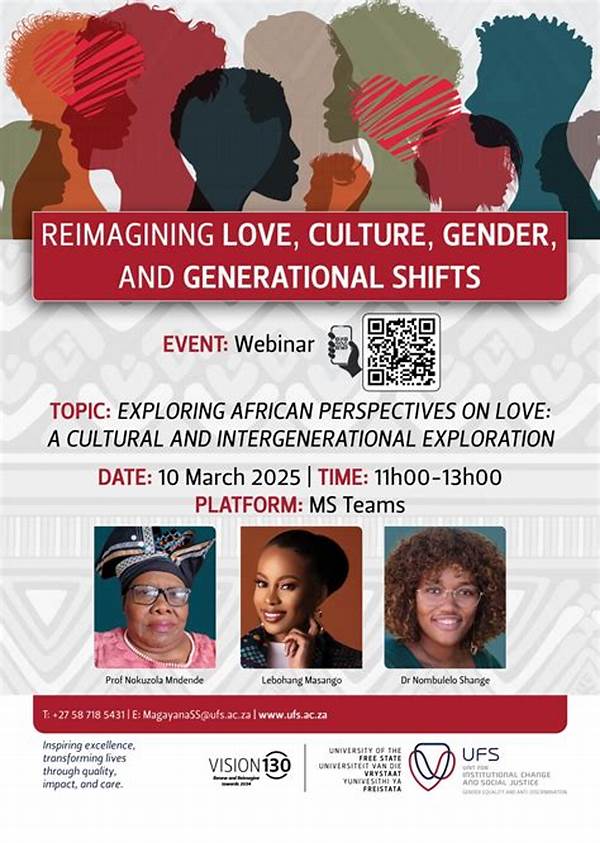The tapestry of love lyrics has evolved dramatically across generations, mirroring the shifting values, styles, and conventions of each era. Love songs have always held a mirror to society, reflecting both the ideals and realities of romance, passion, heartbreak, and everything in between. Each generation, with its unique cultural and social influences, has infused its distinct flavor into the portrayal of love in lyrics. From the poetic and genteel expressions of love in bygone eras to the raw, unfiltered declarations found in today’s music, generational shifts in love lyrics reveal much about the evolution of social norms, relationship dynamics, and linguistic creativity.
Read Now : Intimate Arrangements Of Top Songs
Changing Tunes of Love: Generational Shifts in Love Lyrics
In the mid-20th century, love lyrics were often characterized by a sense of idealism and reverence. Emotions were expressed through poetic metaphors and grand orchestral compositions. Fast forward to the late 20th century, and rock and roll brought a rebellious and candid edge to love lyrics, embracing themes of freedom and defiance. As we moved into the 21st century, generational shifts in love lyrics continued, influenced by hip hop and pop. This era saw the emergence of slang-driven, highly personal narratives, and an increased focus on realism and vulnerability in songwriting.
Nowadays, love lyrics transcend mere romantic storytelling to encompass collective experiences, including joy, loneliness, and self-discovery. Artists today often harness slang and colloquial language to connect with audiences through relatable and authentic expressions. The generational shifts in love lyrics highlight how younger generations favor transparency and humor, with an emphasis on diversity and inclusivity in love themes.
The Power of Slang in Generational Shifts in Love Lyrics
1. In the Mix: Slang keeps love lyrics fresh and current, allowing new generations to express emotions in their own unique voice.
2. Real Talk: This shift sees artists spilling the tea on relationships, using language that feels honest and familiar to listeners.
3. Bops and Beats: Modern love songs are packed with catchy phrases and memes, making them instantly relatable and shareable online.
4. Cultural Vibe: Slang reflects a generation’s identity, shaping how love is portrayed and perceived in music.
5. Emotive Influence: Slang adds emotional depth, making the portrayal of love more authentic and layered in today’s musical narratives.
Slang’s Creativity in Generational Shifts in Love Lyrics
Slang plays a pivotal role in the generational shifts in love lyrics. It injects creativity and authenticity into music, bridging the gap between artists and audiences. In an era where connection is key, slang allows lyricists to speak directly to listeners’ hearts by using words and phrases they understand and relate to. This intimacy has become crucial in building emotional resonance and a sense of community around music.
Moreover, these generational shifts in love lyrics have seen slang transform from a mere stylistic choice to a powerful tool for storytelling. By reflecting the linguistic richness of diverse cultures and communities, slang offers a fresh lens for exploring the complex tapestry of human relationships. This creates an inclusive space for listeners of all backgrounds to find their stories within the lyrics.
The Intricacies of Slang in Generational Shifts in Love Lyrics
1. Flexing Linguistics: Modern love lyrics are linguistic playgrounds, with artists flexing their slang savviness to craft impactful storytelling.
2. Hashtags and Handles: Social media has influenced love lyrics by popularizing hashtags and handles, embedding them into musical dialogue.
3. Local Flavor: Artists infuse local slang into lyrics, adding a personal touch and cultural authenticity to the storytelling process.
4. Cross-Generational Appeal: These generational shifts allow songs to resonate across age groups, as slang bridges generational divides in its expression.
Read Now : Melodic Tales With Enchanting Narratives
5. Playful Tone: Slang lends a playful spirit to modern love songs, inviting listeners to engage with the music in a more lighthearted manner.
6. Touch of Humor: Artists often employ slang humorously, bringing levity to love themes that might otherwise feel heavy or overly sentimental.
7. Instant Virality: Songs peppered with catchy slang phrases often go viral, resonating with the digital age’s penchant for brevity and wit.
8. Cultural Mosaic: Love lyrics reflect the intercultural dialogue happening across the globe, with slang providing a vivid snapshot of this mosaic.
9. Rebellious Edge: By challenging traditional norms, slang gives love lyrics a rebellious flair, encapsulating the spirit of contemporary youth culture.
10. Emotional Rawness: Slang captures the emotional rawness of love, marking a departure from the polished language of past generations.
Crafting Connection: Generational Shifts in Love Lyrics
Slang’s incorporation into love lyrics goes beyond mere expression—it’s about crafting connections in an increasingly decentralized world. The generational shifts in love lyrics emphasize the desire for inclusion and representation in the artistic portrayal of love. By embracing everyday language, artists dismantle barriers between audience and performer, building a community united by shared experiences and emotions.
Modern love songs, infused with slang, spotlight a collective understanding of contemporary relationship dynamics. The generational shifts in these lyrics showcase a commitment to authenticity, as artists candidly explore themes of vulnerability and personal growth. Slang not only captures the rawness of modern love but also serves as a bonding agent, inviting listeners to find solace in shared narratives.
The Evolution Continues: Generational Shifts in Love Lyrics
Capturing emotion through music has always stemmed from society’s pulse. The generational shifts in love lyrics illuminate evolving reckonings with identity, love, and connection. As each generation embarks on its unique musical journey, it carries forward the linguistic legacies of those before while forging new paths through the vibrant tapestry of slang.
In conclusion, the essence of love remains, but the language through which it is expressed constantly transforms. The generational shifts in love lyrics unfold an ever-evolving love story—one that resonates across time, weaving the timeless chords of human connection with the richness of modern-day dialogue. Through the embrace of slang, today’s artists continue this legacy, painting vivid portraits of love that speak to the heart of each new generation.
